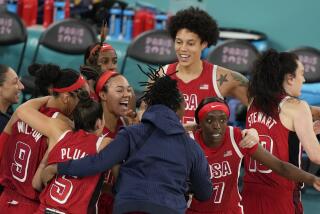Above all the rest
- Share via
STUTTGART, Germany -- The United States’ only Olympic team gold medal in women’s gymnastics came in the raucous hometown environment of the Georgia Dome at the 1996 Atlanta Games. The only world championships team gold medal came in 2003 at friendly Anaheim.
“Now we won it away from home,” U.S. team coordinator Martha Karolyi shouted Wednesday afternoon at the Hanns-Martin-Schleyer-Halle.
For only the second time at the world championships, the Americans put team gold medals around their necks and raised their voices to shout, “USA, USA.”
The U.S. beat defending world champion China by the slim margin of 184.400 to 183.450. Romania was a distant third with 178.100 and was thankful, because the bronze medal became theirs when Russia’s Ekaterina Kramarenko inexplicably balked on the vault by running up to the springboard, screeching to a stop and walking away to earn a score of zero.
Kramarenko’s tears had almost been matched 10 minutes earlier by the U.S. team. So difficult is it for U.S. gymnastics teams to win gold medals that disappointment seemed inevitable when its lead floated away on the slippery foot of Nastia Liukin and the shaky legs of Shawn Johnson.
As 17-year-old Liukin stepped out of her final tumbling pass on the balance beam, she lost her foot grip and turned a double twisting dismount into something stunningly simple, a half flip. Up next, Johnson, a 15-year-old who usually has exuberant poise, followed with a jarring fall off the four-inch-wide piece of wood.
With Liukin in tears and Johnson’s rosy cheeks turned white, the U.S. women marched to their final event, floor exercise, in second place behind China. Alicia Sacramone gathered her teammates and gave them a pep talk. “I just told them we could do it,” Sacramone said.
Even after the meet, Liukin said she didn’t know what happened.
“My foot kind of slipped,” she said. “I did a good beam routine and I guess I just got too excited too early. When I felt my foot slip I knew I wasn’t going to be able to complete the twist.”
A year ago in Denmark, the U.S. also had been the best team in qualifying only to commit uncharacteristic errors on medal day. “It was such a bad feeling last year,” Sacramone said, “just giving stuff away.”
It was Johnson, a high school sophomore, who did the calculations after the disastrous beam routines. “The little math whiz,” said Sacramone, who is going to be a sophomore at Brown University next week. “She figured out we were only a tenth of a point behind.”
Neither the U.S. nor China had nearly the same teams as a year ago. Each had only two returnees, and mostly new 15- and 16-year-olds learning to face up to the kind of pressure expected next summer at the Beijing Olympics.
The finals are contested in an unforgiving format in which each team is allowed three competitors on the four apparatus and all three scores count. The eight finalists are paired. China and the U.S. were together all day and finished together on the floor exercise.
China’s three athletes were up first and the U.S. was offered an immediate opening to the gold medal when 15-year-old Li Shanshan fell on her bottom and skidded off the mat to finish her routine and score a lowly 13.825.
“We couldn’t focus on their mistakes,” Sacramone said. “We had made our own already.”
Karolyi said she had a simple message for the team: “Our strategy after the not-so-successful beam was to go to the next event, think of that next event, think of the preparation and remember past successes on it.”
Up first for the U.S., Shayla Worley cautiously tiptoed through her tasks with no big errors. Johnson followed with an aggressive, in-your-face display of power tumbling and dainty dancing to post a 15.375, the second-highest floor score of the day.
“I knew I needed to make up for beam,” Johnson said. “I was proud I could do that.”
Sacramone said she needed to tell herself to calm down and Liukin whispered, “Just relax and do it,” Sacramone said. She did. Sacramone pounded out a sassy turn, landing each back flip, twisting somersault and double flip with a resounding thud.
By the time her music ended, Sacramone was crying with joy. She was already mobbed by teammates when her score of 15.325 gleamed on the scoreboard.
China Coach Lu Shanzhen had watched stoically as Li had fallen and said afterward that he does not expect to win always.
“It is a competition,” he said. “Same will be next year in Beijing, a competition.”
Karolyi, who turned 65 last week, said while she had enjoyed being part of the other U.S. gold medal teams, there was a better feeling this time.
“When we won before somehow it happened to be in the United States and everyone tried to question the value of it,” she said. “This was a totally neutral place and it was a fair fight, an open field.”
--
--
Top of the world
The United States women’s gymnastics team captured the gold medal in the world championships at Stuttgart, Germany, the team’s third major gymnastics title.
1996 OLYMPICS, ATLANTA
Gold: U.S., 389.225 -- Amanda Borden, Amy Chow, Dominique Dawes, Jaycie Phelps, Shannon Miller, Dominique Moceanu, Kerri Strug.
Silver: Russia, 388.404
Bronze: Romania, 388.246
2003 WORLDS, ANAHEIM
* Gold: U.S., 112.573 -- Terin Humphrey, Courtney Kupets, Chellsie Memmel, Carly Patterson, Tasha Schwikert, Hollie Vise.
* Silver: Romania, 110.833
* Bronze: Australia, 110.335
2007 WORLDS, GERMANY
* Gold: U.S., 184.400 -- Nastia Liukin, Alicia Sacramone, Shayla Worley, Shawn Johnson, Samantha Peszek, Ivana Hong.
* Silver: China, 183.450
* Bronze: Romania, 178.100
- Diane Pucin
More to Read
Go beyond the scoreboard
Get the latest on L.A.'s teams in the daily Sports Report newsletter.
You may occasionally receive promotional content from the Los Angeles Times.






